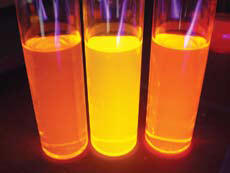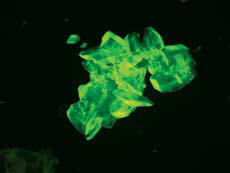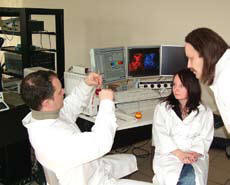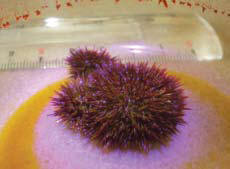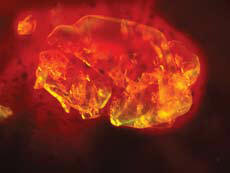|
European Social Fund (ESF) Project “Formation Of Imterdisciplinary Scientific Research Group Working Out And Implementing New Fluorescent Materials And Methods” |
|
PROJECT EXECUTOR:
PROJECT TOTAL COSTS: PROJECT GOAL: PROJECT DESCRIPTION:
The range of existing fluorescent substances will be supplemented by a number of new fluorophores with advanced functional qualities – more intense luminescence, greater photo stability, lower cytotoxicity, etc. The comparison of spectral parameters of the acquired compounds with those of the existing fluorescent probes and selection of more perspective dyestuffs provides an opportunity to optimize the created methods of fluorescence. The acquired outcomes and research literature data will contribute to the investigation of fluorescence regularities by using quantum chemical calculations and mathematical modeling. The spectral investigations of biological objects dyed with fluorescent probes will facilitate the understanding of their structural peculiarities and changes under the impact of diverse external factors. The results will provide for working out different methods of fluorescence analysis for the evaluation of the cell functional state of plants, micro-organisms, and human organism. Application of efficient methods of fluorescent probes will facilitate the research related to ecology and biotechnology problems. Doctoral dissertations and Master theses will be elaborated within the given research. * * * Since ancient times, people have been observing luminescent phenomena, e.g. aurora borealis, lightening, sea luminescence, gleam of glow-worms and some other insects as well as minerals in the dark, yet systematic research of luminescence started only in the 19th century. Over recent 50 years, the range of application of diverse luminescent appliances is growing, e.g. fluorescent lamps, television screens, etc. Luminescence is
radiation the afterglow duration of which significantly exceeds
the period of light fluctuation; it is the cold light as
luminescent substances – luminophores – shine without heating.
Optic radiation is caused by working on the substance by diverse
factors: light (photoluminescence), electrons (cathode
luminescence), γ-rays, protons, α and β-particles
(radioluminescence), X-rays (X-ray luminescence), electric field
(electric luminescence), as a result of chemical and biological
processes (chemiluminescence and bioluminescence). By
interrupting the process of excitation, luminescence continues
for a while. According to the duration of afterglow,
luminescence is divided into fluorescence and phosphorescence.
Fluorescent substances stop emitting light very soon after
interrupting excitation (approximately 10-9 – 10-6s). In the
case of phosphorescence, it continues Luminescent analysis is used for investigating the composition and state of different objects in chemistry, ecology, archeology, biology, medicine, etc. as well as oil search. According to the quantity of oil products in the upper layer of the soil, the direction of boring is determined. This method is used in food industry to test the freshness of foodstuffs, e.g. luminescence of fresh lemons is in yellow colour, while that of a lemon affected by fungus disease is in dark blue colour in the damaged spot. If milk is kept in light, vitamin B disappears and milk luminescence colour changes from yellow to blue. In this way good quality milk may be told from poor quality milk. Meat, flour, eggs, fish and other products are also prone to luminescence. In forensics luminescent analysis is used to track forging of signature, text, securities, etc. due to the different luminescence of each brand of paper and ink. It is also possible to determine the exact age of antiquities or their forging; in medicine this method is used for diagnosing diseases. Already in 1941, fluorescently marked anti-bodies were used to locate antigens in cells; nowadays they are widely used in medical examinations. |
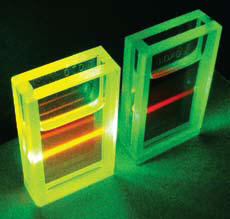
Luminescence of newly acquired dyestuffs in solutions and crystals
Work in microscopy laboratory.
Samples of crystals |


